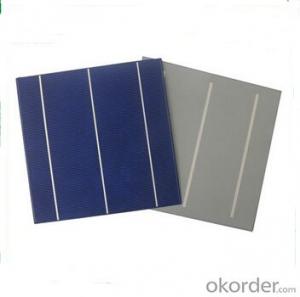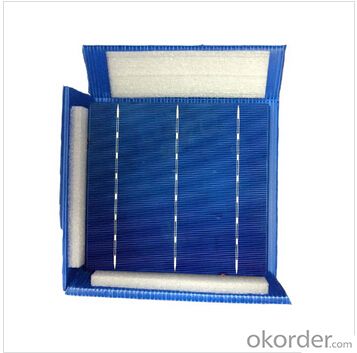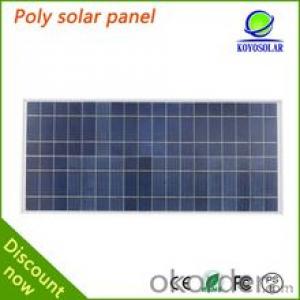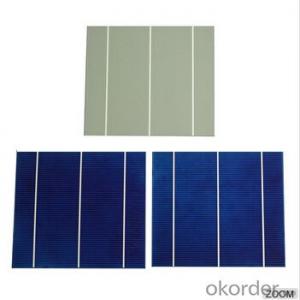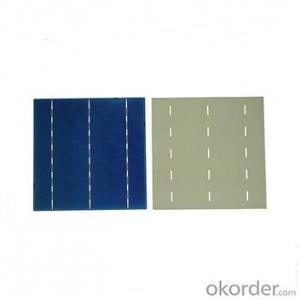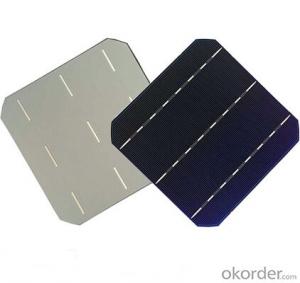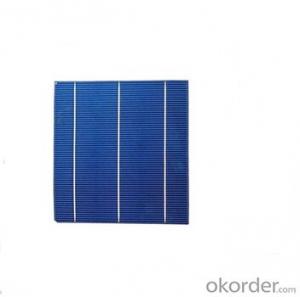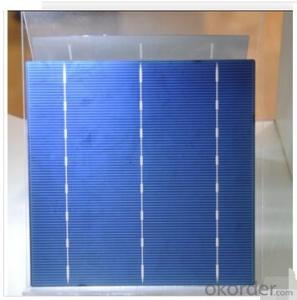Aiko Solar Cells - Polycrystalline Solar Cell High Quality 16.00%-16.25% Effy
- Loading Port:
- Shanghai
- Payment Terms:
- TT OR LC
- Min Order Qty:
- 1000 pc
- Supply Capability:
- 1000000 pc/month
OKorder Service Pledge
OKorder Financial Service
You Might Also Like
Solar Cells:
Solar cells is made by solar wafer, it has three categories of solar cell right now, monocrystalline polycrystalline and thin film,These cells are entirely based around the concept of PN junction, which is the critical part of solar module, it is the part that can convert the light energy into electricity, the thickness is from 180um to 200um, with even busbars to conduct electricity, textured cell can decrease diffuse reflection; they are often electrically connected and encapsulated as a module. Photovoltaic modules often have a sheet of glass on the front (sun up) side, allowing light to pass while protecting semiconductor wafers from abrasion and impact due to wind-driven debris, rain, hail, etc. Solar cells are also usually connected in series in modules, creating an additive voltage. Connecting cells in parallel will yield a higher current;With high quality and stable quality. Our Cells can greatly improve the performance of Solar Modules.
Features:
High efficiencies up to 16.4%
Proven long term mechanical stability of silicone
Make of highly purified poly silicone
Three bus bars for reduced series resistance and improved module and cell efficiency
Blue anti-reflecting coating ensures improved light absorption and increased efficiency
Acid texturization offers a uniform appearance and virtually invisible crystal structure
Excellent low light behavior for improved energy yield
Specifications
Size | 156mm x156mm ±0.5mm | |||||
Thickness | 190um ± 20um | |||||
Front surface(-) | 1.7mm bus bars(silver), blue anti-reflecting coating(Silicon nitride) | |||||
Back surface (+) | 3mm wide soldering pads(silver) back surface field(Aluminum) | |||||
TkVoltage | -0.351%/K | |||||
TkCurrent | +0.035%/K | |||||
TkPower | -0.47%/K | |||||
Efficiency(%) | Pmp(W) | Vmp(V) | Imp(A) | Voc(V) | Isc(A) | FF(%) |
16.25-16.50 | 3.99 | 0.516 | 7.731 | 0.621 | 8.262 | 77.77 |
16.00-16.25 | 3.92 | 0.512 | 7.660 | 0.616 | 8.195 | 77.68 |
Solar Cells Advantage:
1. High efficiency and High power.
2. Long-term electrical stability.
3. Lowest price and Fastest delivery.
4. Good quality and good service.
5.Bulk supply
6. Good Warranty
7.Big Sale
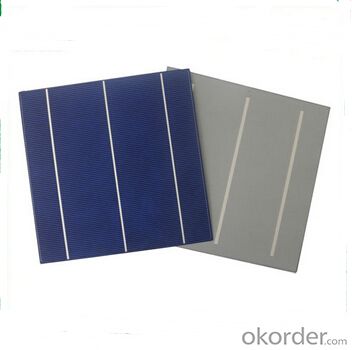
FAQ
We have organized several common questions for our clients,may help you sincerely:
①What price for each watt?
It depends on the efficiency of the solar cell, quantity, delivery date and payment terms.
②How long can we receive the product after purchase?
In the purchase of product within three working days, We will arrange the factory delivery as soon as possible. The pecific time of receiving is related to the state and position of customers.Commonly 7 to 10 working days can be served.
③Can you provide the peripheral products of the solar panels, such as the battery, controller, and inverter? If so, can you tell me how do they match each other?
Yes, we can, we have two companies for solar region, one is CNBM International, the other is CNBM engineering Co.
We can provide you not only the solar module but also the off grid solar system, we can also provide you service with on grid plant.
④What is your warranty of solar cell?
Our product can promise lower than 0.3% open box crack, we support claim after opening the box if it has crackm color difference or sth, the buyer should give pictures immediately, we can not accept the claim after the solar cell has assembled to solar panel.
• Timeliness of delivery
• ⑤How do you pack your products?
We have rich experience on how to pack the solar cell to make sure the safety on shipment, we could use wooden box or pallet as buyer's preference.
- Q: How do solar cells generate electricity?
- Solar cells generate electricity through the photovoltaic effect, where the cells convert sunlight directly into electrical energy. The cells are made of semiconducting materials, usually silicon, which absorb photons from the sunlight. These photons excite the electrons in the material, causing them to break free from their atoms and create an electric current. This current is then collected and used to power various devices or stored in batteries for later use.
- Q: Can solar cells be used at night?
- No, solar cells cannot generate electricity at night because they rely on sunlight to produce energy.
- Q: How long does it take to install solar cells on a rooftop?
- The installation time for solar cells on a rooftop can vary depending on various factors such as the size of the system, complexity of the installation, and the experience of the installation team. However, on average, a typical residential installation can take anywhere from one to three days.
- Q: Can solar cells be used for outdoor signage?
- Yes, solar cells can be used for outdoor signage. Solar cells are capable of converting sunlight into electricity, which can power the lighting or display systems used in outdoor signage. This allows for an environmentally-friendly and cost-effective solution for outdoor signage, as it eliminates the need for traditional power sources and reduces energy consumption.
- Q: Can solar cells store energy for later use?
- No, solar cells cannot directly store energy for later use. They can only convert sunlight into electricity in real-time. However, the generated electricity can be stored in batteries or other energy storage systems for later use.
- Q: Can solar cells be used in public transportation systems?
- Yes, solar cells can be used in public transportation systems. They can be installed on the roofs of buses, trains, and trams to generate electricity from sunlight, which can be used to power various systems such as lighting, air conditioning, and onboard electronics. This helps reduce reliance on fossil fuels and lowers the carbon footprint of public transportation. Additionally, solar cells can also be integrated into bus shelters and charging stations to provide clean energy for electric buses and other vehicles.
- Q: Can solar cells be used in powering irrigation systems?
- Yes, solar cells can be used to power irrigation systems. Solar energy can be converted into electrical energy by solar cells, which can then be used to power irrigation pumps and other components of the system. This makes solar-powered irrigation systems a sustainable and environmentally friendly alternative to traditional methods of powering irrigation systems.
- Q: Can solar cells be used in charging electric bikes?
- Yes, solar cells can be used to charge electric bikes. Solar panels can generate electricity from sunlight, which can then be converted and stored in the electric bike's battery for later use. This allows for a sustainable and renewable source of energy to power electric bikes.
- Q: I am a purchasing manager for a EPC engineering company, and we are planning to purchasing some 4bb solar cells for one of our project in Taiwan, can I get a quotation online?
- We are a professional company selling solar cells. Tomi Fuji is dedicated to provide high quality solar products, ranging from Photovoltaic (PV) cells, PV modules to PV power systems. You can trust us to get the best quality product with the best price.
- Q: How do solar cells impact energy consumption patterns?
- Solar cells have a significant impact on energy consumption patterns by providing a source of clean and renewable energy. They reduce the reliance on fossil fuels and contribute to a more sustainable and environmentally friendly energy production and consumption.
Send your message to us
Aiko Solar Cells - Polycrystalline Solar Cell High Quality 16.00%-16.25% Effy
- Loading Port:
- Shanghai
- Payment Terms:
- TT OR LC
- Min Order Qty:
- 1000 pc
- Supply Capability:
- 1000000 pc/month
OKorder Service Pledge
OKorder Financial Service
Similar products
Hot products
Hot Searches
Related keywords
